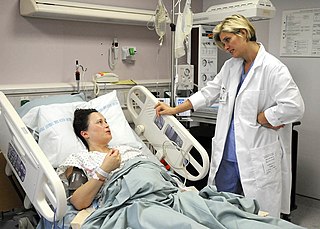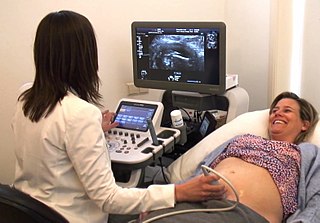
Midwifery is the health science and health profession that deals with pregnancy, childbirth, and the postpartum period, in addition to the sexual and reproductive health of women throughout their lives. In many countries, midwifery is a medical profession. A professional in midwifery is known as a midwife.
Obstetrics is the field of study concentrated on pregnancy, childbirth and the postpartum period. As a medical specialty, obstetrics is combined with gynecology under the discipline known as obstetrics and gynecology (OB/GYN), which is a surgical field.

Childbirth, also known as labour, parturition and delivery, is the completion of pregnancy where one or more babies exits the internal environment of the mother via vaginal delivery or caesarean section. In 2019, there were about 140.11 million human births globally. In developed countries, most deliveries occur in hospitals, while in developing countries most are home births.
A birthing center is a healthcare facility, staffed by nurse midwives, midwives and/or obstetricians, for mothers in labor, who may be assisted by doulas and coaches. The midwives monitor the labor, and well-being of the mother and the baby during birth. Doulas can assist the midwives and make the birth easier. Should additional medical assistance be required, the mother can be transferred to a hospital. This transfer is more likely if an epidural is needed, there is meconium staining, it is a prolonged labor, or the newborn needs intensive care. Some hospitals have birth centers as an alternative to the usual high tech maternity wards.

In the United States, a Certified Nurse-Midwife (CNM) is a nurse midwife who exceeds the International Confederation of Midwives' essential competencies for a midwife and is also an advanced practice registered nurse, having completed registered nursing and midwifery education leading to practice as a nurse midwife and credentialing as a Certified Nurse-Midwife. CNMs provide care of women across their lifespan, including pregnancy and the postpartum period, and well woman care and birth control. Certified Nurse-Midwives are recognized by the International Confederation of Midwives as a type of midwife in the U.S.
The Midwives Alliance of North America (MANA) was founded in April 1982 to build cooperation among midwives and to promote midwifery as a means of improving health care for North American women and their families. Its stated goal is to unify and strengthen the profession of midwifery, thereby improving the quality of health care for women, babies, and communities.

The Frontier Nursing Service (FNS) provides healthcare services to rural, underserved populations since 1925, and educates nurse-midwives since 1939.

Queen Charlotte's and Chelsea Hospital is one of the oldest maternity hospitals in Europe, founded in 1739 in London. Until October 2000, it occupied a site at 339–351 Goldhawk Road, Hammersmith, but is now located between East Acton and White City, adjacent to the Hammersmith Hospital. It is managed by the Imperial College Healthcare NHS Trust.
A birth attendant, also known as skilled birth attendant, is a health professional who provides basic and emergency care to women and their newborns during pregnancy, childbirth and the postpartum period. A birth attendant, who may be a midwife, physician, obstetrician, or nurse, is trained to be present at ("attend") childbirth, whether the delivery takes place in a health care institution or at home, to recognize and respond appropriately to medical complications, and to implement interventions to help prevent them in the first place, including through prenatal care. Different birth attendants are able to provide different levels of care.

Nurses in Canada practise in a wide variety of settings, with various levels of training and experience. They provide evidence-based care and educate their patients about health and disease.

A monthly nurse is a woman who looks after a mother and her baby during the postpartum or postnatal period. The phrase is now largely obsolete, but the role is still performed under other names and conditions worldwide.
Ruth Watson Lubic, CNM, EdD, FAAN, FACNM, is an American nurse-midwife and applied anthropologist who pioneered the role of nurse-midwives as primary care providers for women, particularly in maternity care. Lubic is considered to be one of the leaders of the nurse-midwifery movement in the United States.
Obstetrical nursing, also called perinatal nursing, is a nursing specialty that works with patients who are attempting to become pregnant, are currently pregnant, or have recently delivered. Obstetrical nurses help provide prenatal care and testing, care of patients experiencing pregnancy complications, care during labor and delivery, and care of patients following delivery. Obstetrical nurses work closely with obstetricians, midwives, and nurse practitioners. They also provide supervision of patient care technicians and surgical technologists.
Childbirth in rural Appalachia has long been a subject of concern amongst the population because infant mortality rates are higher in Appalachia than in other parts of the United States. Additionally, poor health in utero, at birth, and in childhood can contribute to poor health throughout life. The region's low income, geographic isolation, and low levels of educational attainment reduce both access to and utilization of modern medical care. Traditional medical practices, including lay midwifery, persisted longer in Appalachia than in other U.S. regions.
In the United States, certified nurse midwives (CNMs) are advanced practice registered nurses in nurse midwifery, the nursing care of women during pregnancy and the postpartum period. CNMs are considered as midwives.
Midwives in the United States assist childbearing women during pregnancy, labor and birth, and the postpartum period. Some midwives also provide primary care for women including well-woman exams, health promotion, and disease prevention, family planning options, and care for common gynecological concerns. Before the turn of the 20th century, traditional midwives were informally trained and helped deliver almost all births. Today, midwives are professionals who must undergo formal training. Midwives in the United States formed the Midwifery Education, Regulation, and Association task force to establish a framework for midwifery.

A midwife is a health professional who cares for mothers and newborns around childbirth, a specialization known as midwifery.
In its early history, Mexico was occupied by a large number of indigenous tribes such as the Mayans and Aztecs. In the 16th century, Spain colonized New Spain and took over the land from the indigenous peoples. Though it is now an independent nation, Mexico retains much of the cultural influence of Spain, including its official religion of Catholicism, the Spanish language, and the importance of machismo - the belief that men are superior to women. Mexico also retains much of the traditional beliefs of the indigenous peoples who first occupied the country. Besides Spanish, there are over one hundred different languages spoken in the country today. As a result, the current medical system involves a mix of traditional and Western medicinal techniques.
Midwives in South Africa are nurses who focus on the care of pregnant women and the delivery of babies. Midwives have the ability to work independently in cases of healthy pregnancies and problem-free deliveries; however, they can refer patients to gynaecologists or obstetricians when complications are diagnosed. The majority of pregnant women in South Africa use the public healthcare system, and most of this care is provided by midwives.
Caroline Susan E. Homer is an Australian midwifery researcher and international advocate for women's health rights. She is Co-Program Director, Maternal and Child Health at the Burnet Institute in Melbourne and Visiting Distinguished Professor of Midwifery at the University of Technology Sydney.








